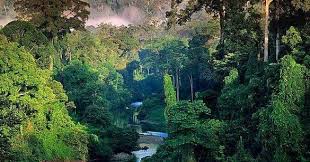16.10.2015
By Carolyn Gregoire
Ten years ago, Mark Pischea, then a 42-year-old political consultant and father of five from Williamston, Michigan, was rushed to the hospital with severe stomach pain.
Pischea was diagnosed with Crohn’s disease, a chronic autoimmune condition that can cause extreme abdominal discomfort, weight loss, fatigue and fevers. For the next decade of his life, the formerly healthy husband and father lived in a constant cycle of flare-ups, surgery and recovery.
After his fifth surgery, Pischea was bedridden for six weeks. At that point, he was told his only remaining options were a sixth surgery or the removal of his stomach. He said that he felt ready to die.
But there was, in fact, one other option, albeit an unconventional one. At his wife’s insistence, Pischea got out of bed, boarded a plane and made his way down to a rustic healing center in San Roque de Cumbasa, a tiny village in the Peruvian Amazon.
Pischea spent most of the next three weeks in solitude, following a strict dieta of rice, plantains and specially prepared plant teas. Several times a day, he met with a shaman named Antonio, who prescribed him local plants known to induce vomiting, as a way to cleanse the body and “reboot” the immune system. The shaman’s recommendations also included ayahuasca, a potent hallucinogenic brew, and kambo, the venom of a rain forest tree frog.
Four months later, Pischea is free of not only his Crohn’s symptoms, but also the depression that had developed alongside his sickness.
“For me, being symptom-free is nothing short of a miracle,” he told The Huffington Post. “I’m thankful for each day that I’m feeling well.”
Looking for answers
Pischea is one of a rapidly growing number of Americans struggling with cancer, chronic disease, mental illness and other ailments who have turned to the Amazon for answers that modern medicine has failed to provide them.
“I went to the top Crohn’s clinics in the world and saw the top doctors in the world, and none of them could help me,” Pischea said. “There is a curative quality to the plants in the jungle that you really need to be there in that environment to experience. I think it really does work.”
But the potential medicinal resources of the Amazon — especially the 80,000 plants native to the region, and the shamanic knowledge that often exists only in oral form among the disappearing tribes — remains largely untapped. Despite the fact that 25 percent of modern pharmaceuticals are derived from rain forest plants, currently less than 1 percent of tropical plants have been analyzed for medical purposes.
Even the plant medicines that are commonly used by shamans, as the indigenous medicine men and women are called, are poorly understood by Western doctors. So far, there has been little research aimed at evaluating indigenous plant medicine and shamanic treatment protocols.
But that’s beginning to change. Now, a large-scale new research project is creating the opportunity for a meeting of the minds between traditional and modern medicine, between shamans and scientists.
In Ecuador and Peru, the Runa Foundation — a nonprofit that does conservation work in the Amazon and provides opportunities for economic advancement to indigenous peoples — is working with a new initiative, PlantMed, to build medical clinics for the research of plant medicine, facilities that will be the first of their kind.
“What we’re doing is trying to put together a multidisciplinary team that involves Western-trained physicians and psychologists as well as the shamans that are indigenous to these areas,” Dr. Mauro Zappaterra, a Harvard-trained physician who is on the advisory board of the forthcoming clinics, told The Huffington Post. “It’s bringing together the best minds from Western medicine and from Amazonian, or shamanic, medicine… to create an even better medicine that incorporates all of it.”
Looking to the rain forest for the next miracle drug is hardly a new practice. Pharmaceutical companies have been sending ethnobotanists to the rain forest for decades to test and collect plants with potential medicinal properties. But for all this exploration, there’s been little collaboration between these medical researchers and the people who have been harnessing the healing powers of these plants for thousands of years.
That kind of collaboration is at the core of PlantMed’s mission. At the Naku Center, located in an area of rich biodiversity deep in the Ecuadorian Amazon, researchers from Stanford, Yale and other institutions will work with healers from the Sapara tribe, an endangered society of fewer than 600 people. At the Rios Nete center in Peru, researchers will work with the Shipibo, a larger tribe whose members are well-known for their medicinal wisdom.
At each center, an M.D. and a shaman, with the support of a team of wellness practitioners and clinicians, will care for an initial group of 15 patients using shamanic protocols, while the researchers analyze their treatments using modern technology. The facilities are slated to open early next year.
While modern medicine is the most sophisticated healing system ever designed, it’s “still got a lot of holes in it,” said Dr. Mark Plotkin, an Amazonian ethnobotanist, conservationist and author of the 1994 book Tales of a Shaman’s Apprentice.
“All you’ve got to do is look at pancreatic cancer, insomnia, acid reflux, stress — all these things that Western medicine can’t cure — to realize we need alternatives or additions,” Plotkin told HuffPost. “As Westerners, we’re taught that anything that isn’t done by a white guy in a lab coat isn’t science, but that obviously isn’t true.”
Raine Donohue/Runa Foundation
Dr. Gerard Valentine, a psychiatrist and researcher at the Yale School of Medicine and an adviser for Rios Nete, says that PlantMed’s clinics are “poised to translate an overlooked trove of botanical knowledge into novel, practical and evidence-based modes of treatment.”
Patients will stay at the clinics for anywhere from three weeks to four months, depending on their diagnosis and disease progression. They’ll be assigned both a lead M.D. and a lead traditional healer, who will work together on their case.
“As Westerners, we’re taught that anything that’s not done by a white guy in a lab coat isn’t science, but that obviously isn’t true.”
For each patient, the shaman will conduct a holistic assessment of his or her physical, mental, emotional and spiritual state. The patient will then be given a plant medicine treatment protocol intended to address what the shaman has determined to be the root cause of the patient’s ailment. Meanwhile, the researchers will analyze the shaman’s treatment methods and plant prescriptions, measuring various biomarkers of disease in the patients before and after treatment, and noting both positive and adverse effects.
“It’s creating not only a research center, but a healing center,” Zappaterra said. “Doing research is how you move medicine forward. You ask questions to investigate. Collect the data, analyze the data. See what the effects are, see what the side effects are.”
The first order of business at the clinics? Finding a cure for autoimmune disease.
When the body attacks itself
More than 50 million Americans — that’s 1 in 5 people — suffer from some form of autoimmune disease, of which there are more than 80 known types, including lupus, rheumatoid arthritis, Type 1 diabetes and multiple sclerosis. Of those 50 million people, 75 percent are women.
While treatments with varying degrees of efficacy have been developed, there is no known cure. Some patchwork solutions exist, but rarely are doctors able to identify and address the root causes that have led the immune system to start attacking its own healthy tissue. Often, doctors rely on immunosuppressant drugs such as corticosteroids to shut down the immune system. These drugs carry many side effects and are not always effective.
“There are many autoimmune disorders that affect millions of people around the world, for which there are no cures, and treatments are far from successful,” Runa co-founder Tyler Gage told HuffPost. “So we see a major window for plant medicine to contribute.”
Autoimmune diseases are difficult for doctors even to diagnose, since they’re often heralded by a nebulous constellation of symptoms like fatigue, clouded thinking, frequent colds and feelings of general malaise. For U.S. patients who have been diagnosed with some kind of autoimmune disease, it takes an average of five years and five doctors just to receive a diagnosis, according to the American Autoimmune-Related Diseases Association.
These diseases are mysterious and multifaceted. One possible reason that many anecdotal reports have found shamanic treatments to be effective in treating autoimmune conditions is that they look at the patient holistically, taking into account mental and emotional factors.
“Many researchers are now focusing on ‘psychogenetic’ components of autoimmune disorders, and understanding the psychosomatic origin and nature in these diseases,” said Gage. “The treatment strategies in Amazonian medicine invariably focus on the patient’s interrelated psychological, emotional, physical and spiritual well-being, and often target the intersecting points of these layers.”
In his 2003 book on the link between stress and sickness, When The Body Says No, the Canadian physician Dr. Gabor Maté writes that in nearly every autoimmune patient he has worked with, “underlying emotional repression was an ever-present factor.”
Indeed, a growing body of research has found that stress, childhood trauma, anxiety and other psychosocial factors can play a role in the development of autoimmunity. One study found that patients with rheumatoid arthritis often report having experienced emotional neglect and abuse in childhood, while another found that MS patients exhibit “insecurity that drives their need to seek greater love.” Similarly, lupus patients frequently report histories of childhood emotional deprivation.
This is just one possibility. It could also be the case that some aspect of the Amazonian plants’ unique chemical makeup is particularly well-suited to addressing immune system disregulation.
“It may be that the nature of autoimmune disorders — which in many cases is the body’s inability to distinguish between itself and ‘not itself’ — involve more of a simple on/off switch that something within the plants’ biochemistry or the way they’re administered is able to address,” Rios Nete co-founder Luke Weil told HuffPost in an email.
It’s important to note that shamanic medicine is no magic bullet for autoimmune disease, and it may not be effective for many or even most patients. Still, it seems likely that by learning more about plant-based medicine, we can help advance our understanding of these mysterious diseases, and we just might move toward better treatments in the process.
“The shamans say that God didn’t create a disease without creating a cure,” Pischea said. “The cures are there. We just need to find them.”
Tribes on the brink of extinction
There’s a very good chance that we won’t find these cures, however, if the rampant destruction of the rain forest continues. At a time when people in the West are living longer and sicker than ever before, and chronic diseases have a yearly impact of over $1.3 trillion on the U.S. economy, the Amazon is a largely untapped resource that we can’t afford not to utilize.
As indigenous cultures like the Sapara and Shipibo teeter on the brink of extinction — the Sapara, once a thriving tribe of more than 200,000 people, has dwindled to a group of just 575 — their vast medicinal knowledge, much of which is not preserved anywhere in writing, is likely to disappear along with them.
This would be a grave loss. The Sapara have made profound advances in plant medicine, having established numerous uses for more than 500 different local plants, but little of this knowledge has made its way into Western medicine.
As the Sapara chief told PlantMed, the tribe’s members have a vision of spreading their knowledge.
“They are eager to share their medicine and traditions with the world in a way that is respectful and scientific,” said Gage.
PlantMed is in a unique position to make this vision a reality. The organization has had relationships with the tribes for close to a decade, and is devoted to sharing their knowledge in a respectful way.
Such a collaboration, unfortunately, would be the exception, not the historical norm. The knowledge of native peoples has been exploited by pharmaceutical companies too many times to count. As Plotkin pointed out last year in a popular TED talk, when a billion-dollar AIDS drug was developed from the venom of a Brazilian snake long used for medicinal purposes by native peoples, the Brazilians didn’t see a penny of that money.
“There’s a wrong way to [work with these tribes], which has been done before, and a right way to do this, which we have an outline for, but it isn’t being done,” Plotkin told HuffPost.
The new research centers could be that “right way.”
“We see the clinic as a platform to nurture and empower the knowledge held by these communities, as well as the plants that underpin these treatments — particularly as both are disappearing rapidly,” Weil said. “We aim to demonstrate their value to the rest of the world with the hope of arresting this destruction.”
Pischea, too, hopes that these treatments will be available to others who are struggling with chronic diseases. Today, he is enjoying good health and renewed energy. There’s always a risk that his symptoms could return, as is the case with any autoimmune condition, but he’s taking it one day at a time.
“The potential is that a lot of people who are suffering unnecessarily could feel better,” he said. “I think even many Western doctors are starting to see that there are answers that are beyond textbooks, and that they need to be open to whatever will do right by their patients.”
For more information on Naku and Rios Netes, or to support the project, click here.




 Creative Commons Attribution
Creative Commons Attribution